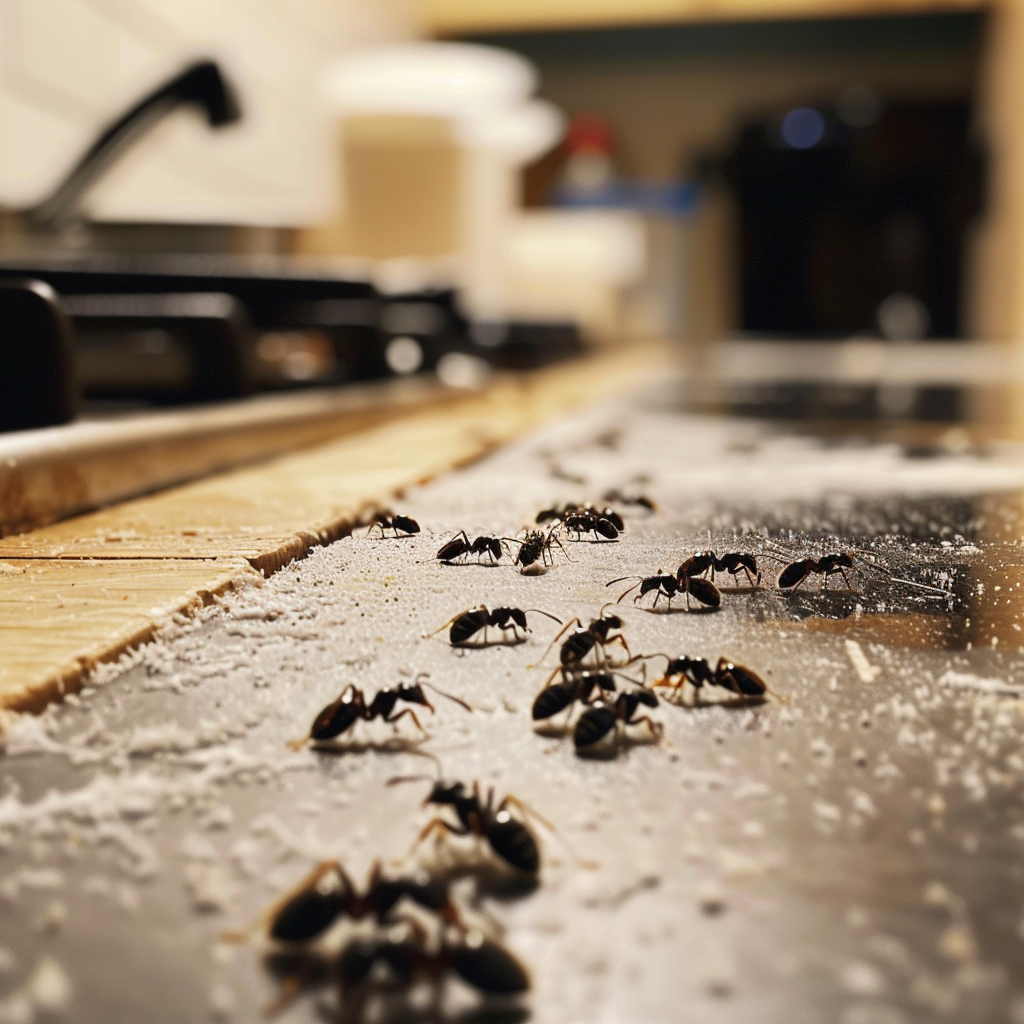Top 3 Effective Ways to Get Rid of Ants in Your Kitchen Safely

Share
Top 3 Effective Ways to Get Rid of Ants in Your Kitchen Safely
Ants can be a persistent problem in the kitchen, where food and water sources are plentiful. While completely eliminating ants can be challenging, there are effective methods to control and reduce their presence. Here are the top three ways to rid yourself of ants in the kitchen safely, ensuring a pet- and child-friendly environment.
1. Identify and Eliminate the Source
Step 1: Find the Ant Trail
Tip: Observe where the ants are coming from and follow their trail back to the entry point. This will help you identify how they are getting into your kitchen.
Why It Works: Understanding the entry points allows you to block them and prevent more ants from entering.
Step 2: Seal Entry Points
Tip: Use caulk to seal cracks and crevices around windows, doors, and other entry points. Ensure that all potential entryways are thoroughly sealed.
Why It Works: Sealing entry points prevents ants from getting into your kitchen, cutting off their access to food and water sources.
Step 3: Remove Attractants
Tip: Keep your kitchen clean and free of food crumbs and spills. Store food in airtight containers and regularly take out the trash.
Why It Works: Eliminating food and water sources reduces the attractiveness of your kitchen to ants, making it less likely for them to invade.
2. Use Natural Ant Repellents
Step 1: Vinegar Solution
Tip: Mix equal parts of vinegar and water in a spray bottle. Spray the solution along ant trails, entry points, and areas where ants are frequently seen.
Why It Works: Vinegar disrupts the scent trails that ants use to navigate, making it harder for them to find their way back to food sources.
Step 2: Essential Oils
Tip: Use essential oils like peppermint, tea tree, or lemon oil, which are natural ant repellents. Soak cotton balls in the oil and place them in areas where ants enter or frequent.
Why It Works: The strong smell of essential oils repels ants and masks their scent trails, deterring them from entering your kitchen.
Step 3: Diatomaceous Earth
Tip: Sprinkle food-grade diatomaceous earth around entry points, along baseboards, and other areas where ants travel.
Why It Works: Diatomaceous earth is a natural powder that dehydrates and kills ants by damaging their exoskeletons upon contact.
3. Use Commercial Ant Baits and Traps
Step 1: Place Ant Baits
Tip: Place ant bait stations in areas where you have seen ant activity, such as along trails and near entry points. Follow the manufacturer's instructions for best results.
Why It Works: Ant baits attract ants with a food-based lure that contains a slow-acting poison. The ants carry the bait back to their colony, where it is shared, eventually killing the entire colony.
Step 2: Use Ant Traps
Tip: Set up ant traps in strategic locations around your kitchen. These traps contain a sticky substance or poison that captures and kills ants.
Why It Works: Ant traps provide a targeted approach to eliminating ants, capturing and killing them before they can spread throughout your kitchen.
Step 3: Monitor and Replace Baits and Traps
Tip: Regularly check ant baits and traps to ensure they are still effective. Replace them as needed to maintain control over the ant population.
Why It Works: Continuous monitoring and replacement of baits and traps ensure that the ant control measures remain effective over time.
Ensuring Safety for Pets and Children
When using commercial ant baits and traps, it is crucial to keep them out of reach of pets and children. Here are some tips to ensure safety:
- Use Pet-Safe and Child-Safe Products: Look for ant control products labeled as safe for use around pets and children.
- Place Baits and Traps in Inaccessible Areas: Position ant baits and traps where pets and children cannot reach, such as under appliances or inside cupboards.
- Secure Baits and Traps: Use double-sided tape or adhesive strips to secure baits and traps in place, preventing pets and children from knocking them over.
- Supervise Pets and Children: Keep an eye on pets and children in areas where ant control products are used.
- Educate Your Family: Teach children to avoid touching ant baits and traps and to notify an adult if they find one out of place.
Additional Tips for Preventing Ants
- Keep Surfaces Clean: Wipe down countertops and clean up spills immediately.
- Store Food Properly: Use airtight containers for food, especially sweet items.
- Fix Leaks: Repair leaky faucets or pipes to eliminate water sources.
- Regular Garbage Disposal: Take out the trash regularly and use a trash can with a tight-fitting lid.
- Trim Plants and Trees: Ensure plants and trees are not touching your home’s exterior walls, as they can provide entry points for ants.
Understanding Ant Behavior
- Scent Trails: Ants use pheromone trails to communicate and navigate. Disrupting these trails can confuse and deter ants.
- Colony Structure: Ant colonies rely on worker ants to bring food back to the nest. Targeting the colony, not just individual ants, is crucial for effective control.
- Nesting Habits: Ants often nest in dark, hidden places such as wall voids or behind appliances. Identifying and treating these areas is key to controlling an infestation.
While completely eliminating ants from your kitchen can be challenging, these top three methods—identifying and eliminating the source, using natural repellents, and employing commercial ant baits and traps—can significantly reduce their presence. Combining these strategies with regular cleaning and proper food storage can help keep your kitchen ant-free. Ensure the safety of pets and children by following safety tips and using pet-safe and child-safe products. Understanding ant behavior will enhance your efforts to maintain a clean and ant-free kitchen.


